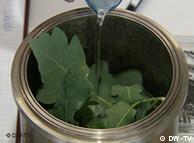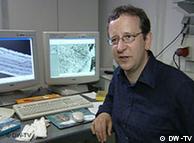from: http://www.dw-world.de/dw/article/0,2144,2071791,00.html
A Stroke of Genius? A New Recipe for Coal
Markus Antonietti from the Max-Planck Institute has developed a simple
but ingenious way of producing coal using biomass - such as waste from
the garden or leaves from the local forest.
The process is environmentally friendly, as the only by-product
is water - not carbon dioxide which would contribute to global warming.
Antonietti has successfully managed to develop this method so that it
could be used for commercial coal production. Such coal could just be
used for heating purposes, but it could be used far more effectively in
electricity and gasoline production. The 70 million tonnes of biomass
that Germany produces every year would be sufficient to cover the
country's energy needs.
We take a closer look at this potentially revolutionary discovery.
--------------------------------------------------------------------------------------------
What is this chemist doing for in the woods armed with a pair of scissors?
He's gathering the ingredients for a very special recipe.
 Bildunterschrift: Großansicht des Bildes mit der Bildunterschrift:
Bildunterschrift: Großansicht des Bildes mit der Bildunterschrift:
Markus Antonietti from Max Planck Institute for Colloid and
Interface Research: "I'm collecting leaves and twigs. We want this
material to solve one of the great problems of the age."
It's the problem of the planet's energy supplies. Markus Antonietti
wants to use a technique he's developed to cook up some coal, based on
the way nature does it.
 Bildunterschrift: Großansicht des Bildes mit der Bildunterschrift:
Bildunterschrift: Großansicht des Bildes mit der Bildunterschrift:
But instead of millions of years, his method takes only a few hours.
But stop! First the ingredients.
The biomass goes into the autoclave, a kind of pressure cooker.
Leaves, pine cones and other plant residues are put into the pot. Water
goes in, too, along with a citric acid catalyst. The mixture releases a
lot of heat - in other words, energy.
Markus Antonietti from Max Planck Institute of Colloids and
Interfaces: "We underestimated this when we started. We could calculate
how much energy was stored in the sugar - in the leaf material. But the
first time - as you see - we had a runaway reaction, which is obviously
dangerous, so we need to carry it out under safe conditions."
 Bildunterschrift: Großansicht des Bildes mit der Bildunterschrift:
Bildunterschrift: Großansicht des Bildes mit der Bildunterschrift:
Now the reaction is being carried out in an experimental "kitchen"
on the roof of the institute. Here it's no problem if the hydrothermal
carbonization, as the process is called, causes minor explosions.
It's all part of the joy of experimentation for the 46 year old
director of the Max Planck Institute of Colloids and Interfaces.
Antonietti says he's only been able to pursue this simple idea since
establishing himself in his field.
It really is a simple reaction. The ingredients just have to be heated....
...for 12 hours at 180 degrees Celsius.
And the coal is ready.
The single major by-product of the reaction is water, which can
filtered off. In contrast to other biomass techniques this reaction
does not generate carbon dioxide. And it gives a higher-energy product,
which even smells acceptable.
Markus Antonietti from Max Planck Institute of Colloids and
Interfaces: "It has a strong smell. (Very masculine.) Like tobacco."
If it were up to Antonietti, this reaction could go large-scale. The
50,000 tonnes of plant refuse that accumulate yearly in Berlin could be
converted into 20,000 tonnes of usable carbon.
 Bildunterschrift: Großansicht des Bildes mit der Bildunterschrift:
Bildunterschrift: Großansicht des Bildes mit der Bildunterschrift:
Markus Antonietti from Max Planck Institute of Colloids and
Interfaces: "The Max Planck Society only does basic research. But with
enough engineering back-up, we could establish this in two to five
years. It's very simple, there just has to be support for it."
Could this laboratory coal be produced on a large scale? Antonietti
says it makes economic sense. The energy needed for the heating is no
greater that that required by other methods.
Until that day comes, the Max Planck scientists intend to go on with their research.
They want to study their laboratory coal in detail. This is the structure of a pine cone before ...
... and after carbonization. But not all coal is alike.
Markuis Antonietti from Max Planck Institute of Colloids and
Interfaces: "Like in a restaurant you can have your steak rare or well
done. We can adjust our coal to be just a bit refined, or we can cook
it until it's like hard coal. One end of the spectrum is topsoil, the
other is hard coal."
 Bildunterschrift: Großansicht des Bildes mit der Bildunterschrift:
Bildunterschrift: Großansicht des Bildes mit der Bildunterschrift:
When the researchers cook their coal mixture for just five hours, the result is topsoil,
This nutrient-rich earth can be used to help barren landscapes bloom.
Soft lignite requires nearly as much cooking as hard coal. But in
order to get energy out of the laboratory coal, it doesn't necessarily
have to be burned.
Markus Antonietti from Max Planck Institute of Colloids and
Interfaces says: "We are dreaming of a carbon fuel cell. That would be
direct electrochemical conversion of the coal, without the actual
burning process. Other applications are in chemistry, for example,
directly making gasoline out of the coal."
 Bildunterschrift: Großansicht des Bildes mit der Bildunterschrift:
Bildunterschrift: Großansicht des Bildes mit der Bildunterschrift:
The scientists intend to pursue those dreams, using nature as a
model. Their next project is to make petroleum - which is a stage in
the production of coal. So sometime in the near future these laboratory
visions may find a place in everyday life....

